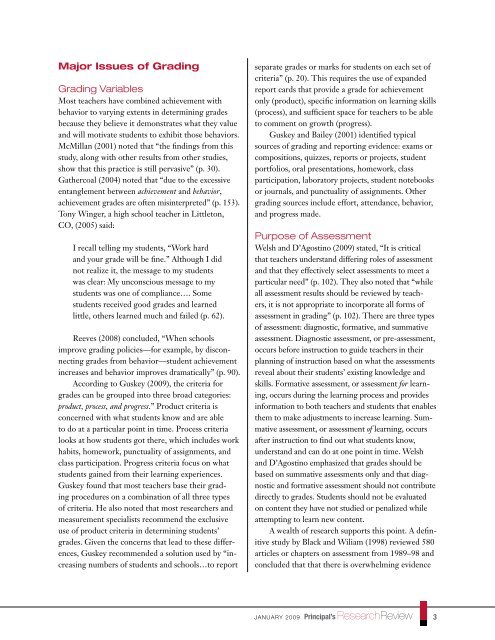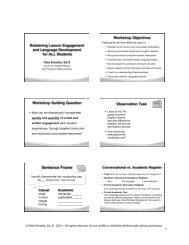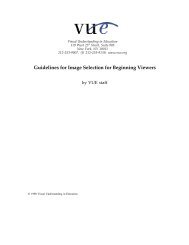Reforming Grading Practices in Secondary Schools - eStaffRoom
Reforming Grading Practices in Secondary Schools - eStaffRoom
Reforming Grading Practices in Secondary Schools - eStaffRoom
You also want an ePaper? Increase the reach of your titles
YUMPU automatically turns print PDFs into web optimized ePapers that Google loves.
Major Issues of <strong>Grad<strong>in</strong>g</strong><br />
<strong>Grad<strong>in</strong>g</strong> Variables<br />
Most teachers have comb<strong>in</strong>ed achievement with<br />
behavior to vary<strong>in</strong>g extents <strong>in</strong> determ<strong>in</strong><strong>in</strong>g grades<br />
because they believe it demonstrates what they value<br />
and will motivate students to exhibit those behaviors.<br />
McMillan (2001) noted that “the f<strong>in</strong>d<strong>in</strong>gs from this<br />
study, along with other results from other studies,<br />
show that this practice is still pervasive” (p. 30).<br />
Gathercoal (2004) noted that “due to the excessive<br />
entanglement between achievement and behavior,<br />
achievement grades are often mis<strong>in</strong>terpreted” (p. 153).<br />
Tony W<strong>in</strong>ger, a high school teacher <strong>in</strong> Littleton,<br />
CO, (2005) said:<br />
I recall tell<strong>in</strong>g my students, “Work hard<br />
and your grade will be f<strong>in</strong>e.” Although I did<br />
not realize it, the message to my students<br />
was clear: My unconscious message to my<br />
students was one of compliance…. Some<br />
students received good grades and learned<br />
little, others learned much and failed (p. 62).<br />
Reeves (2008) concluded, “When schools<br />
improve grad<strong>in</strong>g policies—for example, by disconnect<strong>in</strong>g<br />
grades from behavior—student achievement<br />
<strong>in</strong>creases and behavior improves dramatically” (p. 90).<br />
Accord<strong>in</strong>g to Guskey (2009), the criteria for<br />
grades can be grouped <strong>in</strong>to three broad categories:<br />
product, process, and progress.” Product criteria is<br />
concerned with what students know and are able<br />
to do at a particular po<strong>in</strong>t <strong>in</strong> time. Process criteria<br />
looks at how students got there, which <strong>in</strong>cludes work<br />
habits, homework, punctuality of assignments, and<br />
class participation. Progress criteria focus on what<br />
students ga<strong>in</strong>ed from their learn<strong>in</strong>g experiences.<br />
Guskey found that most teachers base their grad<strong>in</strong>g<br />
procedures on a comb<strong>in</strong>ation of all three types<br />
of criteria. He also noted that most researchers and<br />
measurement specialists recommend the exclusive<br />
use of product criteria <strong>in</strong> determ<strong>in</strong><strong>in</strong>g students’<br />
grades. Given the concerns that lead to these differences,<br />
Guskey recommended a solution used by “<strong>in</strong>creas<strong>in</strong>g<br />
numbers of students and schools…to report<br />
separate grades or marks for students on each set of<br />
criteria” (p. 20). This requires the use of expanded<br />
report cards that provide a grade for achievement<br />
only (product), specific <strong>in</strong>formation on learn<strong>in</strong>g skills<br />
(process), and sufficient space for teachers to be able<br />
to comment on growth (progress).<br />
Guskey and Bailey (2001) identified typical<br />
sources of grad<strong>in</strong>g and report<strong>in</strong>g evidence: exams or<br />
compositions, quizzes, reports or projects, student<br />
portfolios, oral presentations, homework, class<br />
participation, laboratory projects, student notebooks<br />
or journals, and punctuality of assignments. Other<br />
grad<strong>in</strong>g sources <strong>in</strong>clude effort, attendance, behavior,<br />
and progress made.<br />
Purpose of Assessment<br />
Welsh and D’Agost<strong>in</strong>o (2009) stated, “It is critical<br />
that teachers understand differ<strong>in</strong>g roles of assessment<br />
and that they effectively select assessments to meet a<br />
particular need” (p. 102). They also noted that “while<br />
all assessment results should be reviewed by teachers,<br />
it is not appropriate to <strong>in</strong>corporate all forms of<br />
assessment <strong>in</strong> grad<strong>in</strong>g” (p. 102). There are three types<br />
of assessment: diagnostic, formative, and summative<br />
assessment. Diagnostic assessment, or pre-assessment,<br />
occurs before <strong>in</strong>struction to guide teachers <strong>in</strong> their<br />
plann<strong>in</strong>g of <strong>in</strong>struction based on what the assessments<br />
reveal about their students’ exist<strong>in</strong>g knowledge and<br />
skills. Formative assessment, or assessment for learn<strong>in</strong>g,<br />
occurs dur<strong>in</strong>g the learn<strong>in</strong>g process and provides<br />
<strong>in</strong>formation to both teachers and students that enables<br />
them to make adjustments to <strong>in</strong>crease learn<strong>in</strong>g. Summative<br />
assessment, or assessment of learn<strong>in</strong>g, occurs<br />
after <strong>in</strong>struction to f<strong>in</strong>d out what students know,<br />
understand and can do at one po<strong>in</strong>t <strong>in</strong> time. Welsh<br />
and D’Agost<strong>in</strong>o emphasized that grades should be<br />
based on summative assessments only and that diagnostic<br />
and formative assessment should not contribute<br />
directly to grades. Students should not be evaluated<br />
on content they have not studied or penalized while<br />
attempt<strong>in</strong>g to learn new content.<br />
A wealth of research supports this po<strong>in</strong>t. A def<strong>in</strong>itive<br />
study by Black and Wiliam (1998) reviewed 580<br />
articles or chapters on assessment from 1989–98 and<br />
concluded that that there is overwhelm<strong>in</strong>g evidence<br />
january 2009 Pr<strong>in</strong>cipal’s ResearchReview 3






